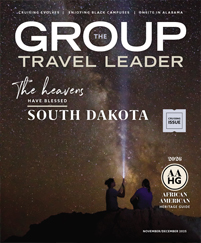
Courtesy San Antonio CVB
San Antonio bleeds personality — spend an hour walking around this Texas city, and you’ll see its colors flowing out of every nook and cranny.
Born of a history that blends Mexican, German and Texan heritage, San Antonio enjoys a carnival of cultures few other domestic travel destinations can match.
The city’s architecture, food and music can make visitors feel as if they’ve traveled to the heart of Mexico. German, Native American and African-American influences also add to San Antonio’s aesthetic.
A visit to San Antonio brings a world of travel possibilities. Group leaders can pack a full schedule of visits to museums and historic sites or give their travelers whole days at leisure to explore iconic areas such as Market Square and the famous River Walk.
Next time your group heads to central Texas, make sure they get to experience some of these essential elements of San Antonio’s colorful culture.
Historic missions
The cultural blend that is San Antonio began in the 18th century, when European missionaries came to the area to proselytize local indigenous groups — as they did throughout much of Central America and South America. Throughout the mid-1700s, Europeans established five missions around what is now San Antonio. Those five structures all remain intact, giving visitors a look into the roots of San Antonio’s culture.
The Alamo is the most famous of the five missions. Situated in the heart of downtown, this structure became famous for a pivotal battle that took place there in 1836 during the Texas Revolution. Today, the museum at the Alamo provides extensive information about the battle.
For a more comprehensive look at colonial life in the area, though, groups should visit the other sites on San Antonio’s mission trail.
“They’re all state parks, so they are run and kept in wonderful order,” said Ronnie Price, associate executive director of the San Antonio Convention and Visitors Bureau. “It’s a great history lesson to see how people lived back then and get a sense of what life was like.
“You can still find them churning and making flour from wheat or see how they used acequias [waterways] to bring water into the missions from the river.”
Among the most popular is Mission San Jose, a 1720 building that features the “rose window,” which has become a visual signature of the city. The best-preserved section of the acequia is at Mission Espada, and Mission San Juan has a bell tower and chapel that are still in use.
Many visitors find Mission Concepcion to be the most beautiful; it was built by Native American stone masons nearly three centuries ago.
Colorful neighborhoods
As San Antonio grew after the early colonial period, neighborhoods began to take on the personalities of the cultural groups that lived there. A visit to these neighborhoods proves a colorful experience.
La Villita, Spanish for “the Little Village,” is perhaps the most visually Mexican neighborhood in town. This was the site of San Antonio’s first nonmission settlement, and the architecture and decoration still reflect Mexican artistic tradition. Today, the neighborhood is home to many artists and crafters.
“It’s a little village full of arts and craft shops and restaurants,” Price said. “I was just walking through the other day, and I saw wonderful jewelers making homemade jewelry, as well as leather goods, pottery and ceramics.
“I saw some people buying candles that had been hand-dipped by the artists who live there in the village.”
In the 19th century, central Texas attracted many German immigrants, who left their own mark on San Antonio. Groups can take tours of the King William neighborhood, which features homes built by German settlers that are now some of the most prestigious residences in town.
“King William is a beautiful neighborhood downtown that reflects German heritage,” Price said. “The Victorian homes are very well kept, and the residents open their doors for tours to come through. It allows you to experience the different heritages that we have in San Antonio.”










